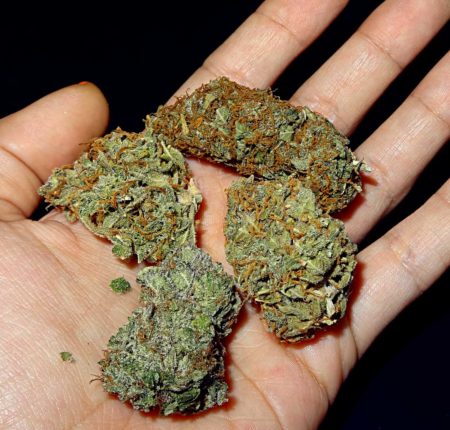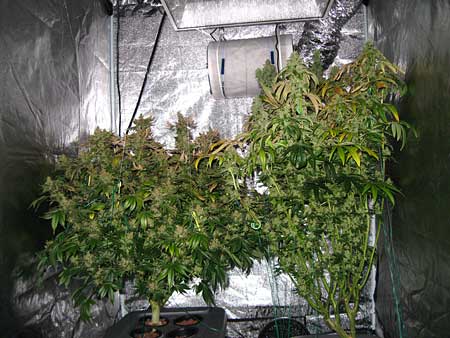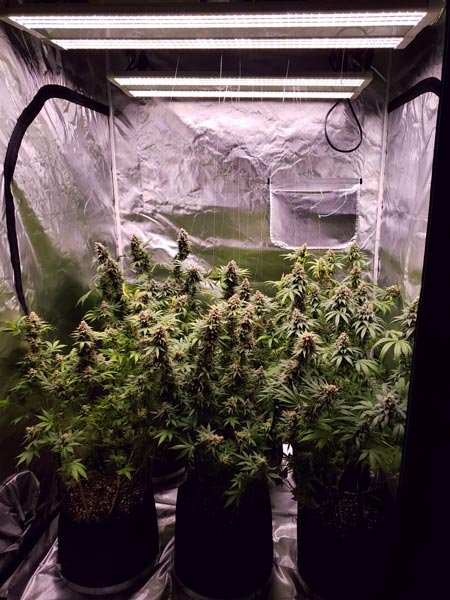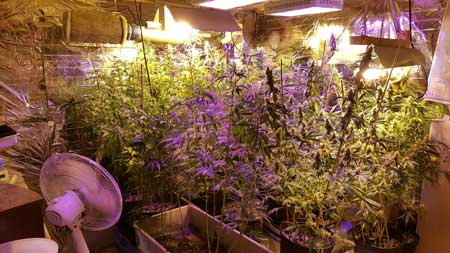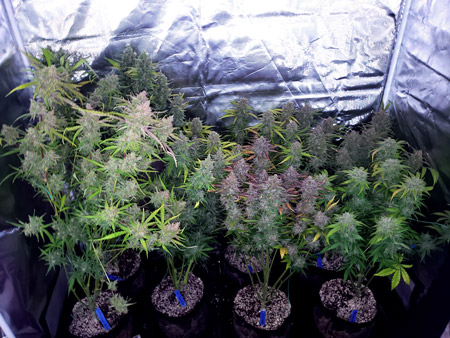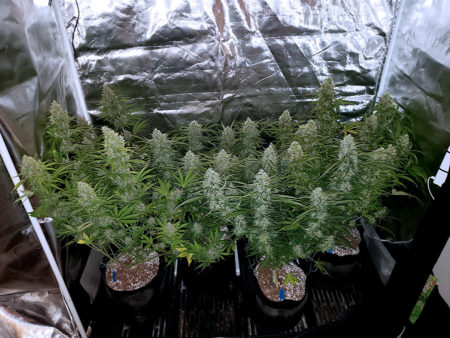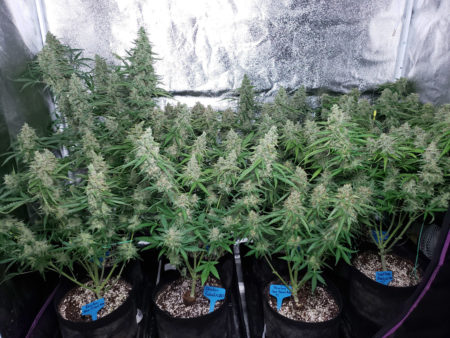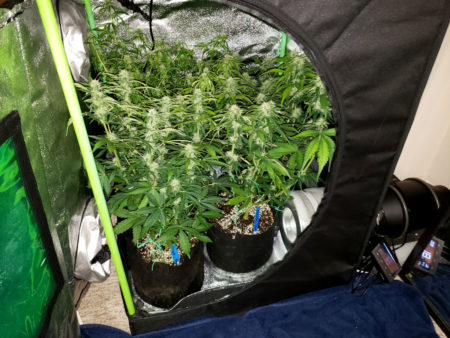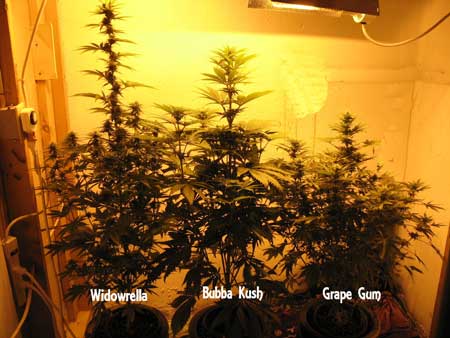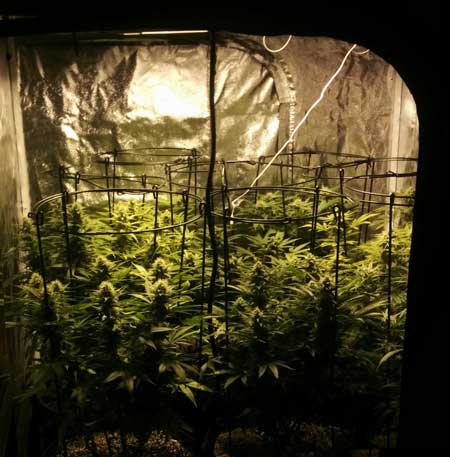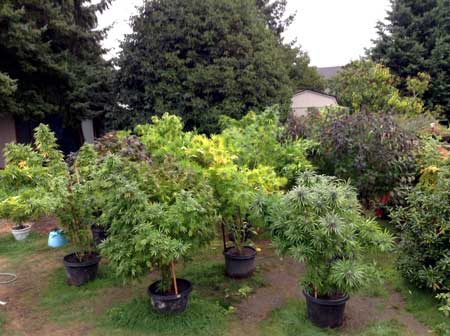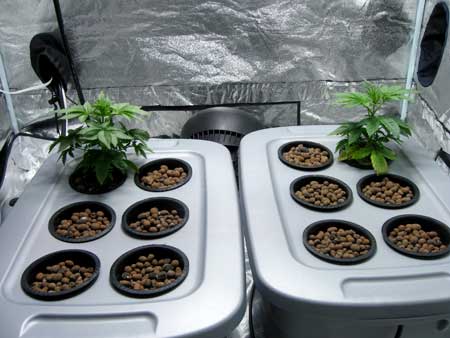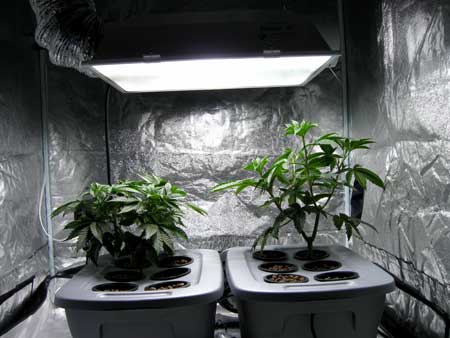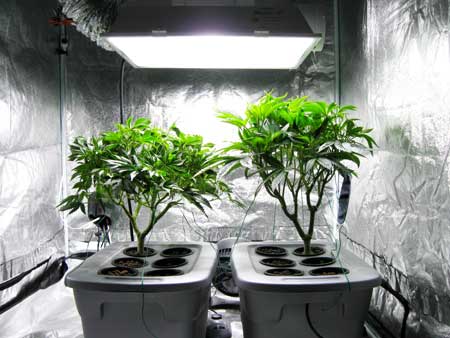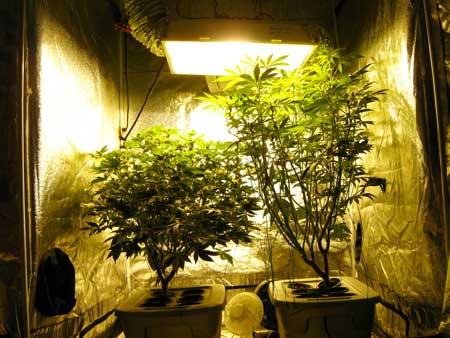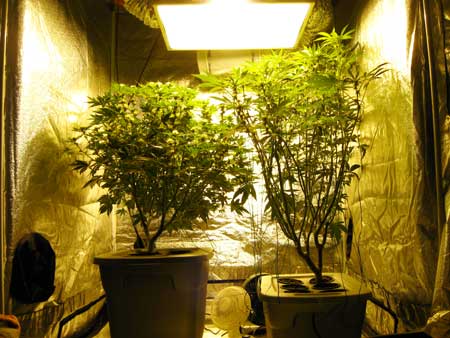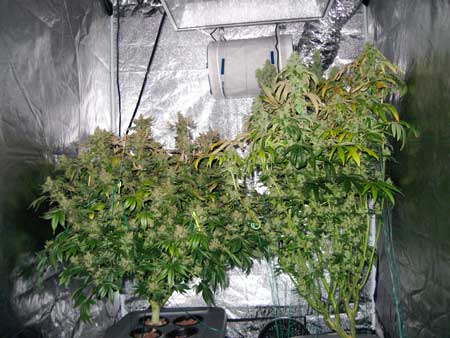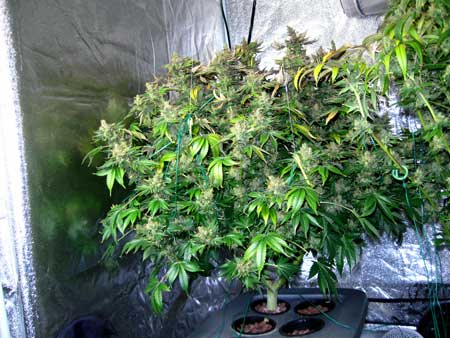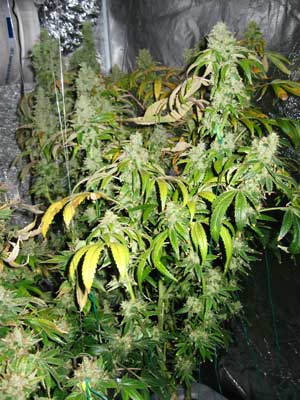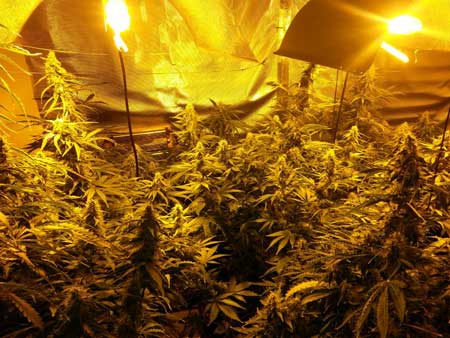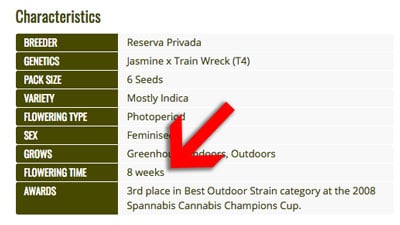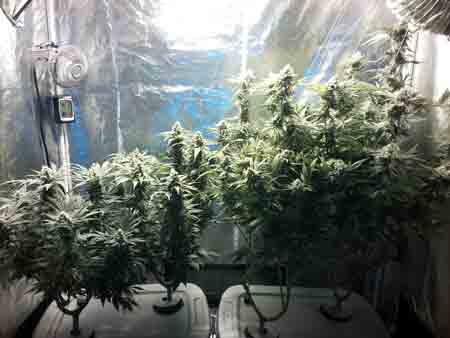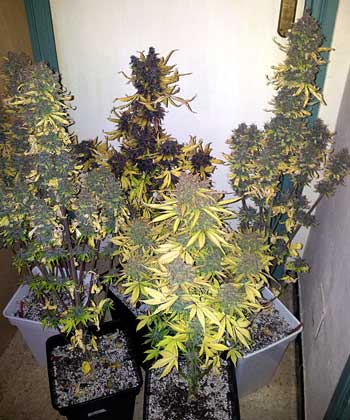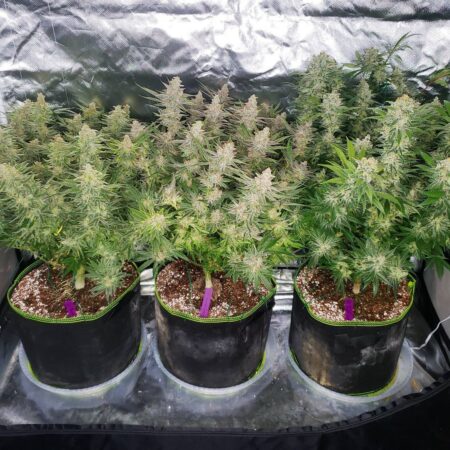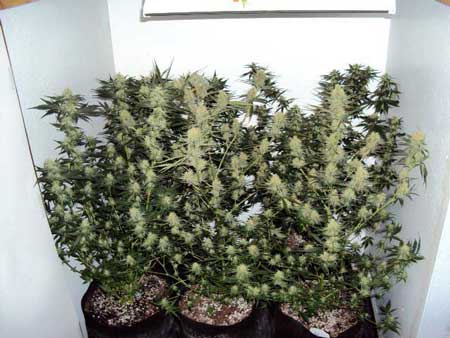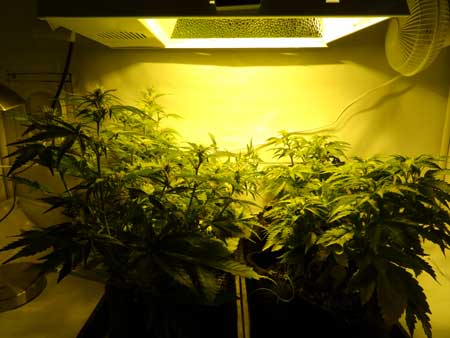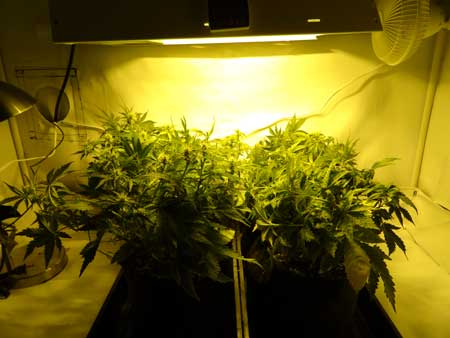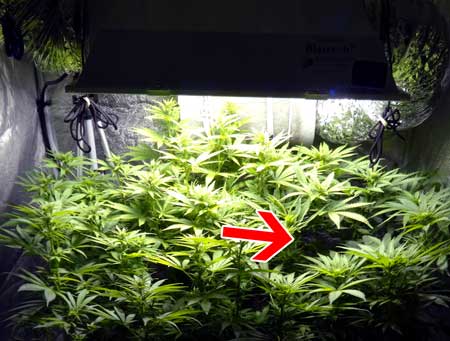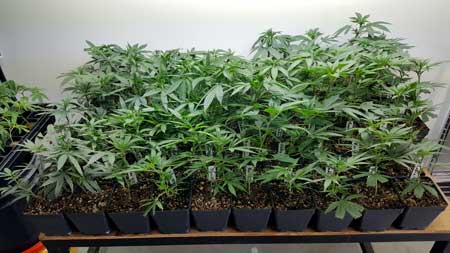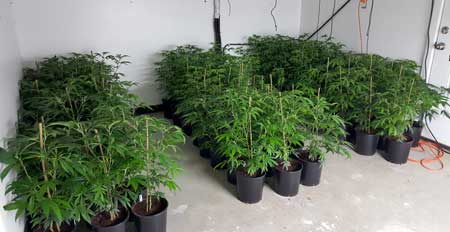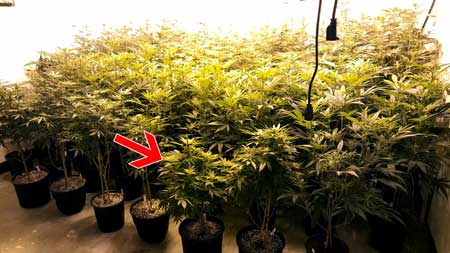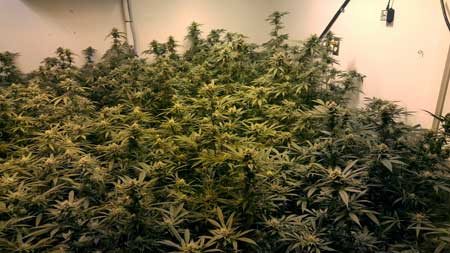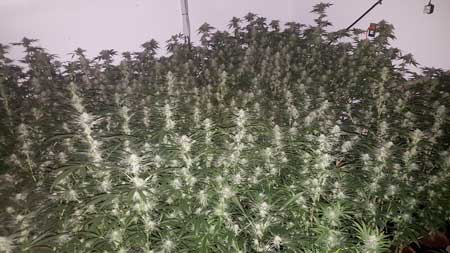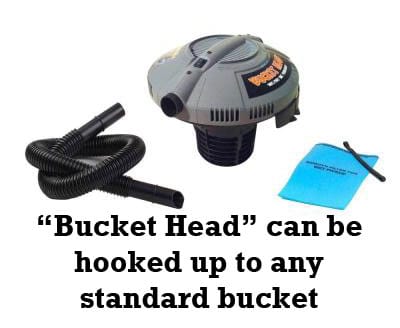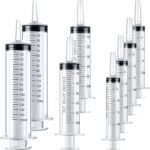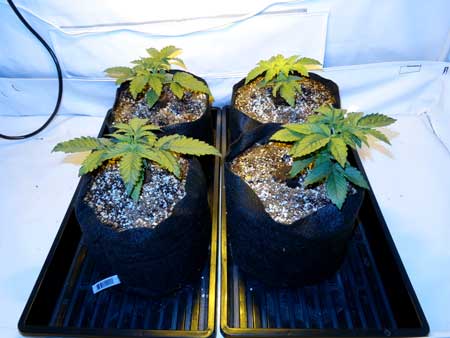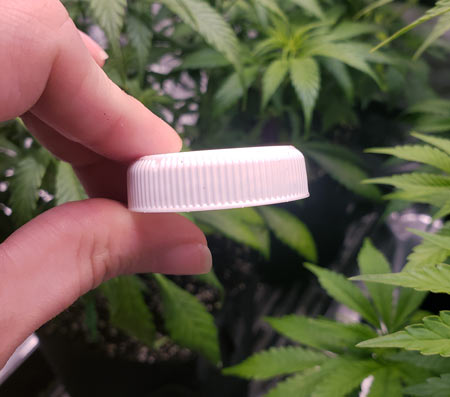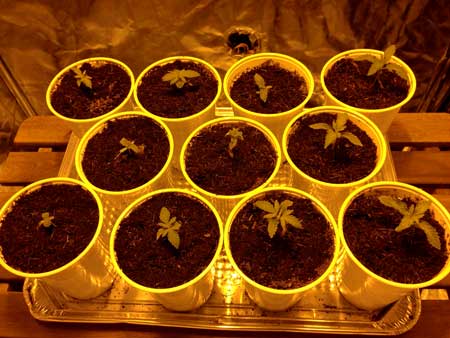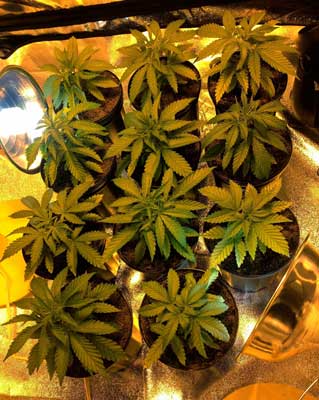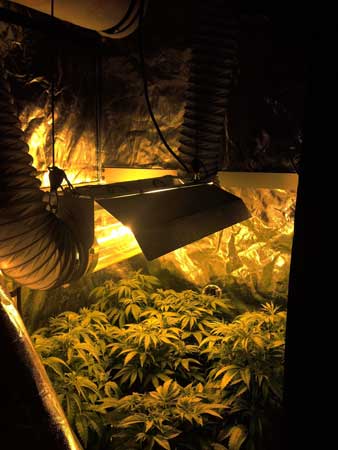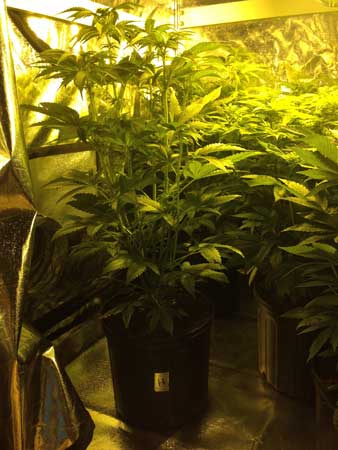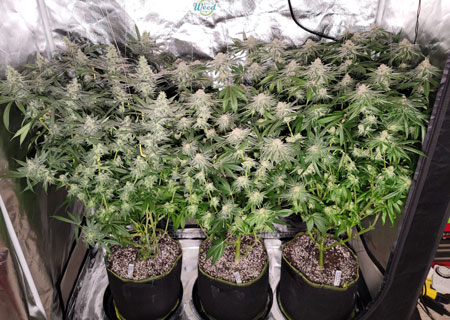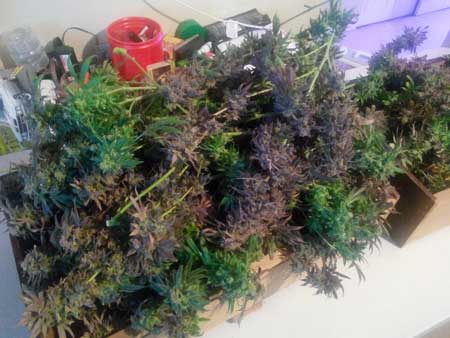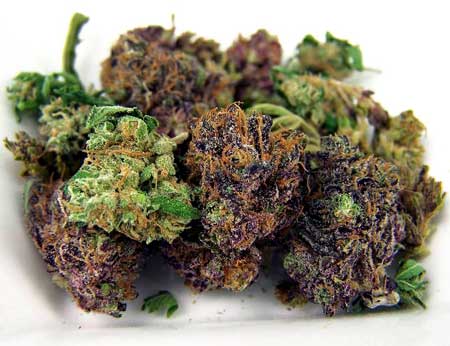by Nebula Haze
Table of Contents
Introduction: How to Grow Multiple Strains Together
Deep Dive: What Difference Does the Strain Make?
- A Tale of Two Strains: Watch the Growth of an Indica vs Sativa Plant (it did not go well)
- How to Pick Strains that Grow Well Together
- 12 Recommended Strains
Introduction: Growing Multiple Cannabis Strains Together
Many indoor cannabis growers want to grow multiple strains together so that they have a greater variety of bud to choose from after harvest. Additionally, maximizing your grow space by growing many plants can increase overall marijuana yields.
Grow multiple different strains at once if you want more variety after harvest.
However, some strains are hard to grow together. They may run into problems related to height, nutrients, or harvest times.
But when done right, you will be rewarded with a sea of buds from different strains every harvest. Learn how today!
Growing Different Cannabis Strains Together
Pros
- Greater variety of strains after harvest
- Growing many plants often increases yields
Cons
- Caring for cannabis plants with different needs may take extra time and effort
- May need to bend or prune taller plants to avoid space or height issues
- Since each strain has its own flowering time, the plants may not all be ready to harvest at the same time
You get more variety if you grow multiple strains at once, but too many strains can get overwhelming.
A common challenge with growing different strains is when cannabis plant heights don’t match up.
Save yourself stress by choosing matching strains that have the same estimated height and flowering time. Matching your strains will help keep the grow space as uniform as possible. This makes growing easier for you.
Minimize small height differences by bending tall branches and tying them down. Another option is to move tall plants to the edges to increase their distance from the grow light.
Good planning goes a long way. With a little plant training and the right genetics, you can grow multiple strains in a remarkably small space.
6 Most Important Tips When Growing Multiple Cannabis Strains Together…
- Try to match the height of each strain – Cannabis seed breeders often list an estimated height for each strain. Some strains tend to grow tall and thin while others are more likely to stay short and bushy. “Tall” strains often grow faster than “short” strains in the vegetative stage, but not always. Tall strains also tend to stretch a lot more after the switch to the flowering stage. Growing strains that grow to the same height on average helps make it a lot easier to manage your garden.
- Choose strains with the same flowering stage timeline – Most cannabis strain descriptions list how long it takes buds to form and mature before harvest. You can harvest strains one at a time as buds become mature, but it’s often convenient to harvest all plants at the same time. A similar flowering stage length for all the strains makes it more likely that each plant needs the same length of time to harvest. Strains with similar timelines also are more likely to grow similar size plants.
- Give all plants equal light (keep them the same distance from the grow light) – Although it’s impossible to give every plant the exact same amount of light, there are important strategies to maximize the light received by your main bud sites. Each grow light has an optimal coverage and less light gets to plants outside that area. Moving tall plants that are getting too close to the light to the edges of the grow space can often help prevent light burn by increasing the distance between the plant and the grow light. Bending and plant training can also be used to control the height of plants that grow taller than desired. A wide flat canopy (shaped like a table) helps give equal light to all your plants.
- Make sure you can reach all the plants – If you’ve got a lot of plants in rows, it can be difficult to reach the plants in the back. This can be tough when it comes to training, diagnosing sick plants, and even basic activities like watering and collecting runoff. Do what you can to make it as easy as possible to reach all plants.
- Pay attention to the size of plants to avoid overcrowding – If you’re not careful in the vegetative stage, it’s easy to overload a grow space if you’re growing a lot of plants at once. When your grow space gets extremely overcrowded, you increase the risk of white powdery mold, bud rot, certain types of bugs, and overall slow growth on plants that get “crowded out.” Plus buds that don’t get enough light tend to stay small and be less potent than they could be. Luckily, a little planning will make things go much smoother.
- Initiate flowering as soon as plants are 1/2 the final desired size – This is a great rule of thumb to help prevent cannabis plants from getting too big. Plants can double in height or more after you give them a 12/12 light schedule, which initiates the flowering stage and gets plants to start growing buds. Ignore this tip if you’re growing with autoflowering strains because they automatically start flowering without any input from you.
These three plants were grown together in the same environment without any training from germination. Even though they were treated exactly the same, they are vastly different heights
Growing multiple strains can be done in an orderly way with some planning and plant training
What You Need to Know About Cannabis Strain Specifications
Each strain has different tendencies when it comes to overall growth speed and estimated height. Some strains grow tall and stretchy, while other strains grow short and bushy. Additionally, different individual plants of the same strain may grow differently from each other, especially if they come from seeds as opposed to clones (which are exact copies of each other).
Each cannabis strain has unique tendencies and characteristics. For example, these outdoor cannabis plants of different strains all turned different colors right before harvest!
How Strains Differ From Each Other
- Bud Quality – Potency (amount of THC, CBD, etc), color, density, flavor, smell, “sparkle” and more are all greatly affected by genetics. Learn about bud quality.
- Height & Growth Speed – Overall “stretchiness” compared to naturally staying short and squat. Some strains tend to just overall grow taller or faster than others.
- Estimated Flowering Stretch – This goes along with height, but basically once plants are switched to a 12/12 light schedule to initiate the flowering stage, they dramatically increase their height before being ready to harvest. Some plants stretch a little, some double in height, and some plants may even triple in height after the switch to 12/12. It’s important to have an idea of what to expect so you can plan for it.
- Length of Flowering Stage – Once a plant has started flowering, the genetics determine how long it takes the buds to mature so they’re ready to harvest.
So before you get started, if you plan on growing many different strains together in the same space, you will be well served by choosing strains that somewhat match each other!
Here’s a picture story of what happens when you try to grow two poorly matched strains together.
A Tale of Two Strains (Indica vs Sativa)
One of the biggest challenges with growing several different strains of cannabis together is the pace of growth. Different strains often grow at different rates in both the vegetative stage and especially during the flowering stretch (the quick growth that happens immediately after the switch to the flowering stage).
Let’s see what happens when you grow an Indica plant next to a Sativa plant in the same setup with the same nutrients!
The left seedling here is an Indica strain that tends to stay short. Right is a Sativa that grows tall. You can see the Sativa is already growing just a touch “stretchier” and less bushy than the Indica, but the difference is growth speeds will become a lot more apparent soon.
Even though both are in the same conditions and have been trained the same way, they look decidedly different as they continue growing. The Indica plant tends to grow very symmetrical and bushy, while the Sativa grows more tall and wild.
A few weeks later, after some plant training and right before the switch to the flowering stage.
Nearly a month after the switch to 12/12, the flowering stretch has mostly stopped. The Indica plant on the left has stretched far less than the lanky Sativa on the right. The plants may get a little taller, but by 4-6 weeks into the flowering stage, they’ll be focused almost completely on making buds.
The grower raised the shorter plant so it could be closer to the light. As is common with Indica plants, it was more sensitive to heat and light, and couldn’t be kept as close to the grow light as the Sativa.
The grower harvested both plants at the same time even though they matured at somewhat different rates. The Indica plant was taken down a little late according to its trichomes, and the Sativa plant was taken down a little early. Which plant do you think ended up getting better yields?
In this case, the Sativa plant ended up getting almost 1.5x the yields of the smaller plant!
Indica Plant at Harvest (6.6 ounces)
Sativa Plant at Harvest (9.3 ounces)
The strain makes an insane difference when it comes to how your plants grow and how much they yield. These plants were grown in the exact same setup, with the same nutrients, grow light, etc, and came out completely differently from each other.
Although you can get around differences like this between strains, it helps greatly to research your strains so you know what to expect in the grow room if you plan on growing multiple strains together.
Finding Strains that Grow Well Together
In this section, I’ll share some tips on choosing strains that “play well” together.
Match the Time to Harvest (Length of Flowering Stage)
In the Tale of Two Strains, we saw how a grower harvested two plants at the same time but one plant was a little early and the other plant a little late. Fortunately, there is a time window of a few weeks where buds can be harvested, but bud effects do change over time.
When growing many different cannabis strains at once in the same grow space, some plants will likely be ready to harvest sooner than others.
On average, most cannabis strains need about 8-12 weeks in the flowering stage after the lights have been switched to a 12/12 light schedule before they’re ready to harvest, though some strains are ready in as little as 7 weeks, and some rare strains from the equator need as long as 16 weeks or more.
The biggest factor when it comes to time-to-harvest is the strain. If you give a bunch of different plants the exact same growing environment, the genetics are going to mostly dictate how long buds take to mature.
Luckily, when shopping for seeds, nearly all strain breeders usually give you an estimated flowering time for each strain
Read more: Why are buds taking forever to mature? (and how to speed the process up)
So if you plan on growing many plants together, consider that a strain that needs an 8-week flowering stage is going to be ready to harvest a lot sooner than a strain with a 16-week flowering stage.
Tip: Breeders often count from the beginning of the harvest window. It’s a good idea to add ~2 weeks to most breeder estimates to achieve peak ripeness, though inspecting the buds is the most accurate way to choose harvest time.
There’s nothing wrong with harvesting your plants one at a time as they become mature, but the length of the flowering stage is something to keep in mind if you prefer one big harvest over a bunch of smaller ones.
The two Aurora Indica plants on left are ready for harvest, while the two Wonder Woman plants on the right still have weeks left to go!
Even though they grew to different heights, these brightly colored auto-flowering plants were all ready to harvest around the same time because the grower matched the strain’s estimated harvest times with each other.
Match the Height
We’ve talked a bit about matching the height of different cannabis strains, but what does that mean? Unfortunately, there is often not that much information available for this. In general, I recommend trying to find strains that are listed as “Medium” height, since this tends to reduce the chance of getting a very short or very tall cannabis strain. If you have a very short grow space, try to get strains listed as being “short”
I recommend trying to find strains that are all listed as having the same height. I usually go for strains listed as “Medium” height. For example, these 3 plants were listed as “Medium” height and generally stayed about the same size as each other. From left to right the strains are Power Africa, Peyote Critical, and Purple Critical Kush.
Note: Sometimes these breeder estimates are just wrong. Cannabis plants are living things and that makes them unpredictable at times. Luckily if you follow all the other suggestions in this tutorial, you’ll still get great results.
Recommended Strains that Match
Short, Quick Photoperiod Strains – These strains tend to stay short and are ready to harvest about 8 weeks after initiating 12/12
- Bubblelicious – Sparkly buds with a hint of bubblegum smell
- Sweet Tooth – Always makes high-quality bud
- Lemon OG Kush – Sparkly buds, tends to stay short, quick to harvest
- Royal Queen Critical – Memorable effects are truly “royal”
Medium Photoperiod Strains with Excellent Yields – These strains grow to a medium height and flowering takes about 9-10 weeks after initiating 12/12. I chose these particular strains because they have big yields and great potency.
- BC Kush – A stabilized Kush strain with great growth and effects
- Blueberry OG – Relaxing effects can be a great option for stress
- Purple Punch – Up to 25% THC in tests, great yields
- Royal Domina – Smooth potency, easy to grow, great smell
Tall – I would avoid growing “tall” strains if you’re growing different strains together.
Autoflowering strains – These auto-flowering strains are all ready to harvest about 10 weeks from germination and grow to a small/medium height
- Girl Scout Cookies Auto – Sweet cookie smell with strong psychedelic effects (high THC, almost no CBD)
- Pineapple Express Auto – Fruity smell and classic effects, a crowd favorite
- Sweet Tooth Auto – Smooth creative potency and beautiful buds
- THC Bomb Auto – Potent and high yielding, lots of “sparkle” on the buds, easy to grow
Give Plants Equal Light (Try Your Best!)
You’ll rarely be able to give all plants the exact same amount of light coverage. If you have a lot of different plants, some plants are going to be bigger or closer to the light despite your best efforts. Just try your best and focus on the plants and buds you are most interested in.
Most of the time, the buds that grow the most dense, long, and thick are located at the top of your plant near the grow lights. So you want to get as many main buds as possible in that position before your plants start flowering.
Notice how the buds get smaller as they get lower on the plant and further from the grow light.
Although it’s impossible to give every plant the exact same amount of light, there are important strategies to maximize the light received by your main bud sites:
Bend over any colas that are getting taller than the others.
When any of your main colas get taller than the others, bend it down and away from the base of the plant, optimally towards a spot under the light that doesn’t have any other buds.
This works best if you’re checking on your plants regularly so you can catch any problem stem(s) early before they get out of control and become difficult to bend over. If you pay attention you can also train unruly stems to fill “holes” in the canopy that are lacking a cola.
If some of the plants or colas are getting taller than the others
Bend all the tallest stems over so they’re the same height as the other colas and plants, and secure in place. Just following that principle as your plants grow will give the shape you want
You can’t fight a plant’s true nature, but you can use plant training to work with it.
Fill In Empty Spots in the Canopy
Whether growing one plant or many, you always want to fill up any “empty” spots in the canopy by bending one of the tallest colas down and into the empty spot. That not only flattens your plant but fills in your canopy with more main bud sites.
This arrow points to an example of an empty spot.
Support Your Marijuana Plants
There are many ways you can physically support your cannabis plants, including stakes, tomato cages, bendable wire, plant ties, etc.
If you’ve got a lot of plants in an enclosed space, you want the flexibility to be able to train your plants to grow into any shape you want. By installing supports when your plants are still young, it gives you a better ability to train your plants because you have more things you can secure your plants with/to.
Additionally, plant supports help big plants from falling over as buds get heavy.
These pictures by commercial grower Davie Jones help illustrate how stakes can be used to support the plants and keep the canopy relatively flat and even. He started with several cannabis plants of different strains.
Each plant was given its own plant stake to hold the plant up as it grows. These also provide a support structure to tie down unruly stems on plants that are getting taller than the others. Many growers also like tomato cages because they give a grower more places to anchor stems from. Initially, there’s room for rows to better reach the plants, but soon they’ll get too big for that.
The plants are allowed to gain some size and get placed in their final destination. Unfortunately, you’ll never get a “perfect” canopy, and that’s okay. Just try your best with the plants you have.
Some plants will always be smaller than others, like the plant this arrow is pointing to.
When you have this many crammed into such a small space, bend over the extra tall stems, give the shorter plants a good place with direct light, and otherwise let the plants do their thing throughout the flowering stage. There are always going to be unruly stems, especially in the back where you can’t reach them.
The grower was rewarded with more than 15 lbs (240 ounces) of premium dried bud from this grow. Huge harvests can be one of the benefits of growing tons of plants, but keeping all your plants in a relatively flat shape like this is what maximizes indoor yields.
Set Up So You Can Reach All the Plants & Collect Runoff
One of the hardest aspects of growing many different plants in a grow space is it can be difficult to reach all the plants, especially the ones in the back. As you saw in the above example, it’s common to see tall, unruly stems in the back of a grow space with a lot of plants.
Whether it’s plant training, watering, or collecting runoff water, it can be hard to tend to the basic needs of a plant when you can’t reach it. But there are a few tricks.
Ideas to Help Care for the Cannabis Plants in the Back
- Multiple Ways to Enter the Grow Space – Set up your grow space so you can access the garden from more than one side (for example a grow tent or room with more than one access door).
- Get Help Watering Plants in the Back – A common tool for this problem is a big watering can to help you reach plants in the back. Or better yet, set up an automatic watering system that uses drip lines to water each plant individually with tubing. Here’s a tutorial. Once an automatic watering system is set up, you won’t have to worry about getting water to the plants in the back.
- Force Runoff Water to Pool to the Front – Put all plants on a slightly inclined tray. For example, put a small piece of plastic under the runoff trays in the back. This causes all the water runoff coming out of the bottom of your pots to come to the front of the tray so you can suck it up with a wet vacuum or industrial syringes. You only need a tiny incline to get all the water to come to the front.
It helps if you can reach plants from multiple sides if you have a big grow space. This 4’x4′ grow tent has a door in front and window ports that can open from the sides to help get to plants in the back.
These plants in trays were put on a slight incline so that runoff water pools to the front for easy collection.
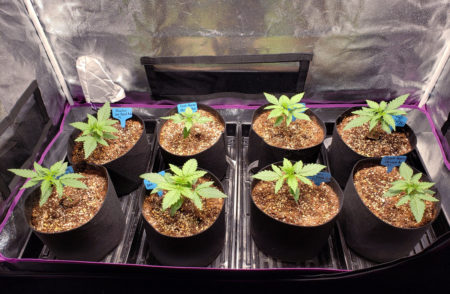
Not sure how to remove runoff water after watering your marijuana?
Wet vacuums can be helpful. I have used a Power Head attachment (also called a “Bucket Head”) which can be turned into a wet vac by hooking it up to any standard 5-gallon bucket. You can buy one online but it’s much cheaper if you get one in person at a Home Depot.
A downside to the Power Head is it’s a little loud, just like most wet vacs. Luckily you only need to use it for a few minutes after watering your plants.
This mini wet vacuum isn’t as loud but only holds about 1.5-2 gallons of water at a time
Those options are great, but they’re loud. Loud sounds may not be ideal if you live in an apartment or have close neighbors. A silent option for removing runoff water (without having to move your plants) is to use a big soft-tip syringe. This allows you to manually suck up the runoff water and squirt it into a container. Best for when you’re not producing a whole lot of runoff at once, though they do have some really big sizes for those who want to go that route.
I live in a condo with neighbors above and below me, so I’m reluctant to use a wet vacuum if I water my plants late I night. Instead, I use this cheap ($15) variety pack of syringes to silently collect runoff water and squirt it into a separate container to dump out. It includes 3 different sizes depending on how much water you need to collect at once. I’ve found I like to use the smaller ones when there is just a little runoff to collect, and the bigger ones if there’s a lot.
Put a small piece of plastic under the back of your plant tray to get all the runoff water to pool to the front. Just a little bit of an incline is all you need.
How to make an incline? Get a small piece of plastic (or anything waterproof) like a bottle cap, lego, etc. If you put this under the runoff tray on the side furthest from you, it will create a slight incline and runoff water will pool forward for easy collection with a syringe or wet vacuum.
Watch Out for Size of Plants / Over Crowding (Especially in Grow Tents)
It doesn’t take long to completely fill a whole room.
When you have a lot of plants in a very limited space – like a grow tent with only a few feet in each direction – it can be easy to overgrow your tent without even noticing it.
It might take 1 or 2 plants several weeks to fill your grow space, but if you’re growing 10 plants at a time they’ll fill that space much sooner.
When growing many different marijuana plants, they will fill up the whole grow space quickly than just one or two plants.
2 weeks later, the 4’x4′ (1.2m x 1.2m) space is quickly getting filled by plants even though each individual plant is still relatively small.
The grower had to toss 4 plants that were males or hermies, but even with just 7 plants left, the entire bottom of the tent is soon covered from wall to wall. A few days after this picture, the grower put these plants in bigger containers and switched to a 12/12 light schedule to initiate the flowering stage.
Try to Initiate the Flowering Stage when Plants are 1/2 the Final Desired Size
Stay aware of the fact that each plant can potentially double in size after the switch to the flowering stage, and certain strains may even triple in size. You need to leave enough room to care for your plants, as well as prevent them from growing into your grow light. So once your plants have reach about half the final size, it’s time to switch to the flowering stage immediately if possible.
This may be easier said than done. Sometimes you may realize too late that your space is overcrowded, or plants may stretch more than expected. If that happens, just try to bend down any stems that are growing into the light, and otherwise try to hold out until harvest. What to do if plants are getting too tall.
Most plants about doubled in size after the switch to 12/12, but this one in the corner tripled. It’s a good thing the grow tent was 6.5 feet (2m) tall.
It’s a jungle in there. With so many plants, it’s a sea of developing buds.
Although it can be a lot of work, growing multiple strains at the same time gives you a bigger variety of buds after harvest, and if you take care of your plants you will also get great yields.
Hopefully, by now, you have at least a rough idea about whether growing multiple cannabis strains together would be a good fit for you, and if so, the best way to go about it. Growing multiple strains can offer great rewards when you put the effort into it.
Who doesn’t love variety?
About the Author: Nebula Haze
I co-founded GrowWeedEasy.com in 2010 and since then I have dedicated my life to teaching people how to grow weed at home. GrowWeedEasy.com has hundreds of tutorials and we add several new ones every month, as well as run side-by-side growing experiments and more. If you enjoyed this tutorial, sign up for our weekly newsletter and get sent a different cannabis growing tutorial every Sunday morning.
Happy growing!
Next, learn how to improve…

